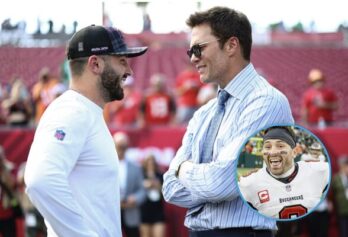Brees’ numbers don’t lie. They just stretch the truth a bit.
New Orleans Saints All-Pro QB Drew Brees is a classic example of why having the best statistics don’t necessarily make you the best player. In this age of stat-obsessed sports fans that are loyal to the fantasy numbers rather than the various aspects of the game that factor into success, it’s important that we keep “numbers” in perspective and don’t allow them to become the end all when ranking our legendary ballers.
Brees is definitely a Top 10 quarterback in NFL history. After all, how can you have the NFL’s all-time leading passer outside of your Top 10?
The Shadow League on Twitter
And here’s the man whose record Brees just passed, Peyton Manning, giving Drew his props. (? @Saints ) https://t.co/MCMZIbYfBY
However, Brees isn’t as great as Peyton Manning — the guy whose record of 71, 940 career passing yards he broke on Monday night with a vintage 62-yard touchdown strike to rookie receiver Tre’Quan Smith.
ESPN on Twitter
Here’s what history sounded like in New Orleans ?⬆️ ?: ESPN #WASvsNO https://t.co/IyUzSqrvAO
Brees’ numbers don’t lie. They just stretch the truth a bit.
Brees finished with 363 yards, three touchdowns, and a career-best 89.7% completion percentage (26-of-29). The numbers are staggering, but totally understandable considering the NFL that Brees has been playing in the past five seasons or so.
Sports Illustrated on Twitter
New Orleans keeps on rolling (via @Saints) https://t.co/F5K8nd3uAY
The NFL has become a pass-crazy league, where defenses are not allowed to traditionally defend receivers or even hit quarterbacks with any force. Teams have basically abandoned the run game and QBs regularly throw 40 times a game or more.
The new rules have skewed everything. Passing numbers are through the roof and the difficulty involved with playing the position is minimal for a polished quarterback who doesn’t have to endure big-hits, threat of a brutal pass rush or physical play by cornerbacks that can knock receivers off their routes or pose difficulties.
The evolution of the game has to be taken into account, as well as the fact that Brees played half of his contests in a temperature-controlled dome. One wonders what kind of stats he’d produce playing in Chicago or New York most of his career. He went from a cup of coffee in San Diego to The Superdome.
Between 2011-2017 Brees threw for 35,179 yards and he eclipsed the magical 5,000 passing mark four times. He didn’t lead the Saints anywhere close to another Super Bowl during that period but he padded his career stats tremendously and has taken full advantage of the NFL’s changes in rules and style of play.
Jalen Rose reacts to Richard Sherman’s NFL helmet rules comment | Get Up! | ESPN
Jalen Rose reacts to Richard Sherman’s comments on the new NFL helmet rules, saying that it was well said and echo’s what most players are thinking but can’t say.
Several rule changes over the years have led to this offensive outburst that we are currently in.
1. Since 1995, the NFL has allowed a WR forced out of bounds by a defender to return in bounds and make a play. This helped eliminate the move of “chucking” a WR out of bounds to remove him from a play.
2. In 1996, the NFL announced they’d actually enforce the illegal contact penalty, created in 1978, more stringently than before. The rule was no longer just a recommendation.
3. In 2001, the NFL announced Roughing the QB penalty would be enforced more strictly and specifically targeted late hits. By 2002, they protected the QB even further by barring helmet-to-helmet contact with a QB at any time, even after a change of possession.
4. The NFL again tightened down enforcement of already existing rules for illegal contact, pass interference, and defensive holding in 2004.
5. QBs received even more protection in 2006 when the NFL barred hits to the QBs below their knees unless the defensive player was blocked into the QB.
6. WRs saw additional protection in 2009 when contact to the head of a defenseless receiver was prohibited. The NFL expanded the rules for defenseless receivers to include all players around 2010. They also threatened an additional crackdown on these penalties and threatened players with suspensions
7. The Ty Law rule was also very influential in NFL passing offenses becoming so dominant in the past decade. It has been compounded by the Tom Brady Rule — defenders cant lunge at QBs legs. The Helpless Receivers rule. And the general impact of CTE, aimed at protecting the heads of players.
It’s not his fault, but the fact remains that Brees isn’t better than Hall of Famer Dan Marino either.
Pete Prisco on Twitter
Whenever I see passing records go, all I can think about is how many Dan Marino would have had playing with today’s rules. Answer: All of them.
Marino was the first QB to pass the 5,000-yard passing mark in 1984.
Marino’s record stood for almost 30 years until Brees broke the 5,000 yard mark for the first time in 2008 and three years later he shattered Marino’s single-season mark of 5,084 yards.
The Best QB Ever Is Dan Marino “AKA” The Blueprint
The best QB of all-time debate is as flammable, spirited and open to interpretation as any sports discussion. One thing is certain. QB passing numbers sure don’t mean what they used too.
Peyton Manning currently holds the record with 5,477 passing yards in 2013. Brees is the only NFL quarterback to reach 5,000 yards more than once, having done so five times. In 2011 three different players, Tom Brady, Drew Brees, and Matt Stafford threw for over 5,000 yards. It’s startling proof of how the game has changed and how passing numbers must be analyzed totally differently in today’s age.
This isn’t a knock on Brees. He certainly got his props from every GOAT in the sports, entertainment and political world on Twitter.
LeBron James on Twitter
Salute @drewbrees!! Congrats on the achievement/milestone. Sheesh that’s a lot of passing yards!! ????
Russell Wilson on Twitter
Drew… you have inspired me. Grateful for you for doing it for the “Short Guys.” @DrewBrees
TheBillRussell on Twitter
Congratulations to @Saints @drewbrees the @NFL new all-time passing leader! In 2010 I presented him with the @SInow Sportsman of the year award. Well done Drew!
Barack Obama on Twitter
Congratulations to Drew Brees on the all time passing record. Always a class act.
New Orleans Saints on Twitter
Drew Brees’ close friend and New Orleans’ own @TheEllenShow with a message for No. 9! #goSaints https://t.co/N9OzS565C8
The GOAT Tom Brady— another QB Brees isn’t better than — said it best on a recent radio interview with WEEI in Boston in reference to the short adjustment period for young quarterbacks flooding the league and having instant success.
Back in the days, quarterbacks needed to get some polishing on the pro level and learn how to deal with the heightened contact, strategy, ferociousness and overall intensity and speed of the NFL game. Now, these guys stop right in and start chucking for 300 yards.
“I think now, in some ways, pro football is more glorified college football…I think football now, removing some of the physical elements of the game, it’s more of a space game.”
The second half of Brees’ career marks the beginning of a kinder, gentler NFL, driven by big money, big offense and the quarterbacks as the most cherished, untouchable commodity in the league.
The same challenge isn’t there anymore for the best quarterbacks. Offensive contact with the defender is less and less for quarterbacks, running backs and receivers. Throwing for 4,000 and 5,000 yards doesn’t mean the same thing anymore. So while the greatness and consistent dominance of Brees and his partner in crime and HC Sean Payton should definitely acknowledge and cherished in NFL lore; his stats put him in the GOAT conversation, but they don’t get him ahead on the NFL quarterback Mount Rushmore.



